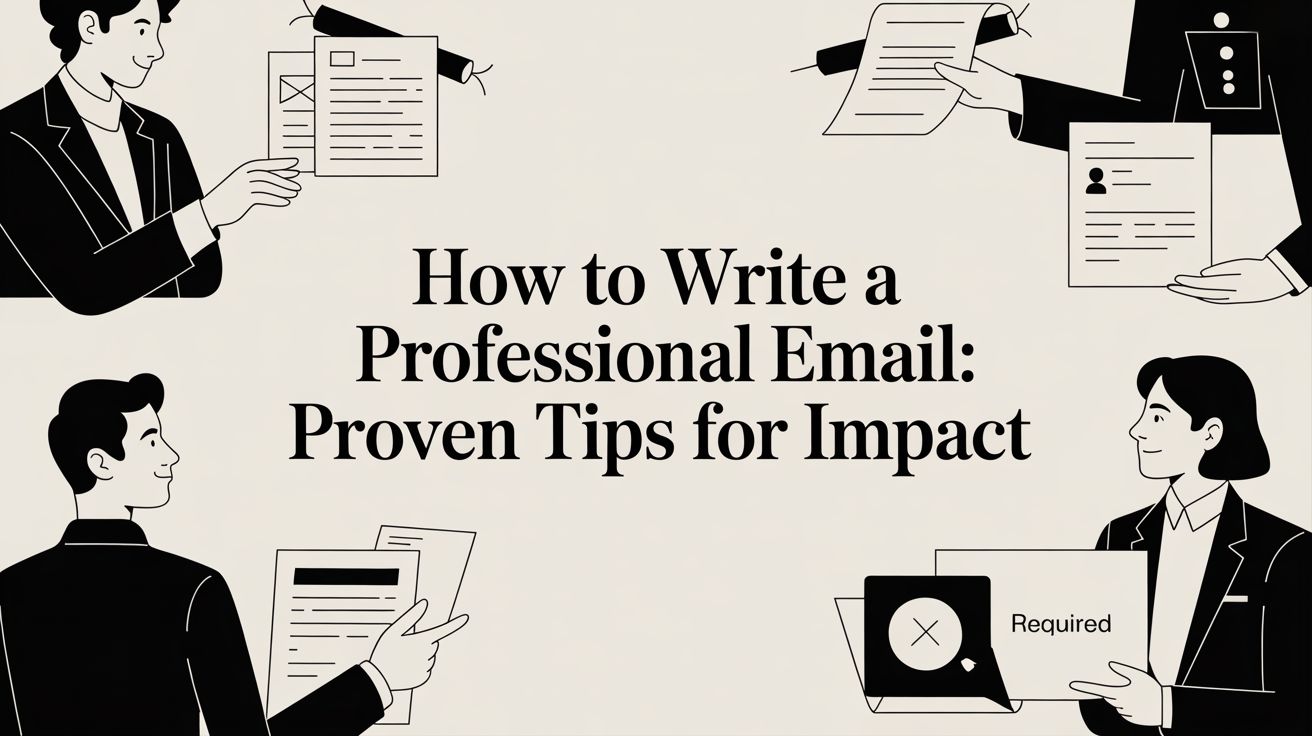Email is an important way to talk to people in personal and business settings. Good email etiquette is important for making a long-lasting impact. This blog post talks about how to properly write and send emails, as well as common mistakes people make. You'll know how to write professional, thoughtful, and impactful email replies by the end of this post.
How to Use Proper Email Etiquette
The rules for proper email etiquette are the building blocks for good digital conversation. Understanding and following basic email etiquette rules can make your replies clearer and more professional and have a bigger impact. The following part will discuss some important email etiquette rules that will help you write better emails.
Use a Professional Email Address
It's best to use a professional email address that shows who you are or what you do when you respond to emails. Don't use personal or unprofessional email addresses because they might make a bad impact. Your email address should include your name or a version of it. This makes it easy for people to find you.
Reply Right Away
Responding to emails on time is an important part of proper email behaviour. You should answer emails within 24 to 48 hours or sooner if the situation is important. Responding too slowly can make people angry and make it harder to communicate. But if you need more time to get information or think of a good answer, you can quickly acknowledge the email and give an idea of when you will send your full response.
Be Polite and Courteous
It's important to keep a polite tone in your email responses if you want to build good relationships. Always start your email with a polite greeting, like "Dear [Recipient's Name]" or "Hello [Recipient's Name]." Choose the right greeting for the amount of formality and your relationship with the recipient. When writing your email, make sure to use nice words and phrases and stay away from sarcasm and rude comments.
Use Simple and Clear Language
When you respond to an email, it's important to be clear and to the point. Don't use jargon or scientific terms that the other person might not understand. Instead, use clear, simple language. Sort your ideas into logical groups and show the information in a structured way. If you want to make a point or give a lot of information, you might want to use bullet points or numbered lists.
Use Proper Grammar, Spelling, and Punctuation
For professional email conversations, it's important to use correct grammar, spelling, and punctuation. Before you send your email answers, make sure they are correct and easy to understand by proofreading them. Use tools that check your spelling and language to find any mistakes you might have missed. Making spelling or grammar mistakes can make you look less skilled and less interested in the details.
Pay Attention to Tone and Feeling
Because emails don't have body language, they can be interpreted differently than the sender meant. Pay attention to the tone and feelings you show in your email responses. Try to keep a calm and professional tone and avoid words that are too emotional or hostile. Think about things from the other person's point of view and try to show care and understanding when needed.
Following these basic email etiquette rules will build a strong foundation for good conversation and set the stage for good email replies. In the next part, we will discuss the structure of a well-written email reply.

How to Structure Your Email Reply
Writing a well-structured email response is important for ensuring your message is clear and makes sense. This part will cover the most important parts of writing a good email reply, such as knowing the difference between formal and informal situations, beginning your email, writing the body, and ending your email.
Differentiating Between Formal and Informal Situations
It's important to think about the situation and amount of formality before writing your email reply. Emails can be used for everything from business communication to casual chats with coworkers or friends. To ensure your email reply sounds right, you should know the right formality and tone. To figure out the right amount of formality, think about who you're writing to, what the email is about, and how you already feel about that person.
How to Write Greetings in Email
The first sentence of your email sets the tone for the whole thing. Before you start your email reply, be sure to greet the person by name and be polite. "Dear [Recipient's Name]" is a good greeting for formal emails, while "Hi [Recipient's Name]" is a better greeting for casual talks. Being too casual is never a good idea. It's better to be too serious than too casual.
Writing Your Reply Accordingly
In the body of your email reply, you should say what you want to say, give information, and answer any questions or address any concerns that were made in the original email. Putting your ideas into paragraphs or bullet points will help them be clear and make sense. It will be easier for the person reading your answer if each paragraph concerns a different point or topic. Avoid using jargon or complicated terms that aren't needed, and write in clear, short language. Give more context or past information to support your answer if you need to.
Closing Your Email
In the same way that the beginning sets the tone, the end of your email makes an impact that lasts. Tell the person you're thankful for their time and thought. If you want to be more professional, you could end with "Sincerely," "Best regards," or "Thank you." Don't forget to sign off with your name and any needed contact information, like your phone number or email signature.
Planning and thoughtfully structuring your email reply makes it easier to read and more powerful. The following parts will talk about specific ways to respond to emails, such as formal, informal, complaint, and job offer emails.

How to Reply to Certain Types of Emails
When you reply to different emails, it's important to ensure that your answer fits the original message's setting and goal. This part will talk about how to respond to four common types of emails: business emails, casual emails, complaint emails, and job offer emails. You will be able to write suitable and effective responses if you know the subtleties of each type.
Answering a Business Email
You should usually be polite and professional when you write a formal email. Ensuring that your answer to a formal email is as formal as the original message is important. Be polite, use the right greetings, like "Dear [Sender's Name]," and follow standard business rules. Formal wording that is short and to the point is best. Answer any questions or concerns brought up in the first email in a clear and complete way. Put a suitable ending phrase at the end of your email, like "Sincerely" or "Best regards," and then write your name and contact information at the bottom.
Replying Casual Email
When writing an informal email, you can use a more laid-back and friendly tone, especially when talking to friends, coworkers, or people you know. You can write in a more casual way when responding to a casual email. Start with a friendly welcome, like "Hi [Sender's Name]" or "Hey [Sender's Name]." Use words and phrases that are right for the person and the situation. Respond in a casual way while still being responsible. Answer the question in the original email by giving your ideas, opinions, or any information asked for. End with a friendly phrase like "Take care" or "Talk to you soon," then write your name.
Responding to a Complaint Email
If someone emails you a complaint, it's important to respond to them with understanding and respect. Start by recognizing their issue and letting them know you understand how upset or frustrated they are. If you need to, say sorry and tell them you understand how they feel. Explain in clear, detailed language how you plan to fix the problem or offer a solution. Stay neutral and focused on finding an answer instead of being defensive or rude. As you end your email, reassure the customer that you care about their happiness and say something sincere, like "Thank you for bringing this to our attention" or "We appreciate your feedback."
How to Reply to an Email Job Offer
When you get an email with a job offer, it's exciting, and your response should show how excited and professional you are. Begin by saying thanks for the offer and your interest in the job. Confirm that you're interested in the job offer and list any conditions or standards that must be clarified. Now is the time to ask any questions you have. Always write your email in a nice and professional way. As you wrap up, say again how grateful you are for the chance and how eager you are to help the group succeed. Use the right ending, like "Sincerely" or "Best regards," and write your name at the end.

Tips to Reply to an Email Correctly
Email reply manners and best practices are important if you want to stay professional and communicate clearly in your replies. This part will discuss some important things to consider and ways to improve your email replying skills.
When to Answer
It's very important to respond to texts quickly. Try to answer quickly, ideally within 24 to 48 hours, unless the email must be dealt with immediately. It's fine to acknowledge the email and give an estimated time frame for your reaction if you need more time to give a thoughtful and complete answer. But don't wait longer than you have to; it can make people angry and make it harder for them to communicate.
Making Sure Your Answer Is Clear and Brief
It's important to be clear and to the point when writing email replies. Use clear, simple words to get your point across for the best results. Don't use long lines or too many details that could confuse the reader. Instead, make your answer easier to read by dividing it into clear parts or bullet points. If the email needs a more in-depth explanation, you could attach relevant papers or give more information.
Proofreading Your Email Replies
Please read over your email answers carefully before you send them. Check for spelling, language, and punctuation mistakes. Also, read your email out loud to ensure it makes sense and has no unclear or confusing language. Also, check the receiver's name and any other important information twice to ensure it's correct.
How to Keep Your Replies Professional
In all email answers, it is important to maintain a professional tone and attitude. If necessary, don't use slang or informal wording. Be polite and respectful if you disagree with the sender's point of view. Use the right salutations, greetings, and closings to show your responsibility. Remember that emails are easy to forward or save, so always think about how your words might affect people in the future.
Managing Email Length
While giving enough information is important, remember that your email responses should not be too long. Emails with many words can be hard to read and make it easy to miss important details. Make sure your email is short and to the point and that it addresses the main points that were brought up in the first letter. If you need to, include extra information or files that can be used as references.
Replying to All Questions and Concerns
When you react to an email, it's important to answer all of the sender's questions and address any concerns they may have. Spend some time reading the original email and making sure your answers or solutions are complete. If there is more than one question or point, you might want to number your answers to make them clear and avoid any misunderstanding.
Following these rules for how to reply to emails properly will improve your communication skills, strengthen your work relationships, and ensure that your emails are read and understood. In the next part, we will discuss common mistakes you should avoid when replying to an email. This will help you stay professional and avoid making these mistakes.

Common Mistakes to Avoid When Replying to an Email
When you reply to an email, it's important to avoid making common mistakes that can make your answer less useful. In this part, we'll talk about some common mistakes you should avoid to stay professional and communicate clearly.
Using the Wrong Tone or Language
If you want to avoid making a big mistake, don't use bad language or tone in your email answers. Don't use rude or disrespectful language because it can hurt your reputation and relationships. No matter what, always be polite and thoughtful, even if you disagree with the sender. When giving constructive feedback, you should be polite and careful.
Ignoring the Original Email
You should read the original email carefully and make sure you understand it before you reply. Ignoring or missing important points or questions the sender asks can cause confusion and make communication less useful. Spend time listening to each worry and responding in the right way to make sure that all the important problems are understood and fixed.
Not Adding the Right Sign-Off
Not properly signing off on an email can make it look like you didn't pay attention or aren't professional. At the end of your email, you should always use a proper closing line, like "Sincerely," "Best regards," or "Thank you." This makes the email more formal and complete. Also, don't forget to add your name and any useful contact information to your email header.
Ignoring Spelling, Grammar, and Punctuation Mistakes
Spelling, grammar, and punctuation mistakes can make your email answers look less trustworthy and professional. Before sending your email, read it over and look for any mistakes or typos. Use tools that check your spelling and language to find any mistakes you might have missed. A well-edited email with no mistakes shows that you paid attention to the details and improved your answer.
Skipping the Proofreading Step
It is important to proofread your email answers for clarity, coherence, and spelling and grammar mistakes. By reading over your answer, you can ensure that it gets your point across clearly and effectively. Make sure your ideas are put together in a way that makes sense and that the email moves well from one point to the next. This helps people understand, makes you look more professional, and improves how you talk to people.
You can make sure that your email responses are smooth, professional, and useful by not making these common mistakes. Take the time to read over and change your answers. Pay attention to the language, tone, content, and general clarity. You will improve at writing email replies that make a good impact and help you communicate effectively with time.

